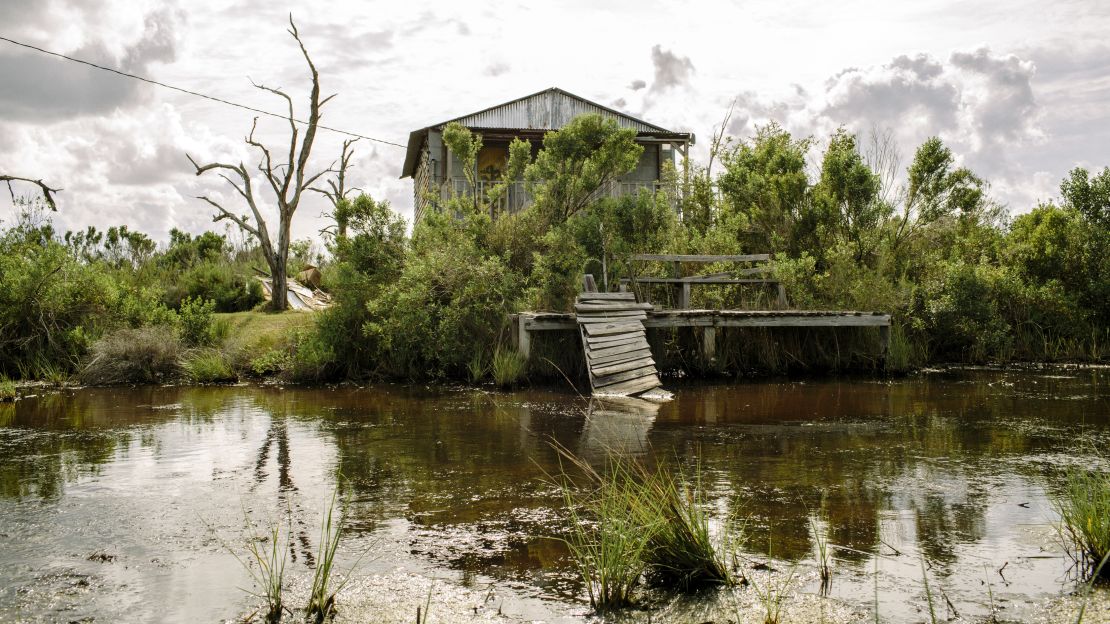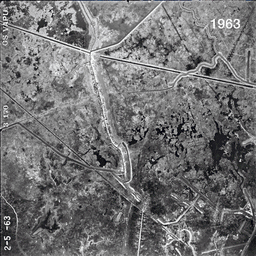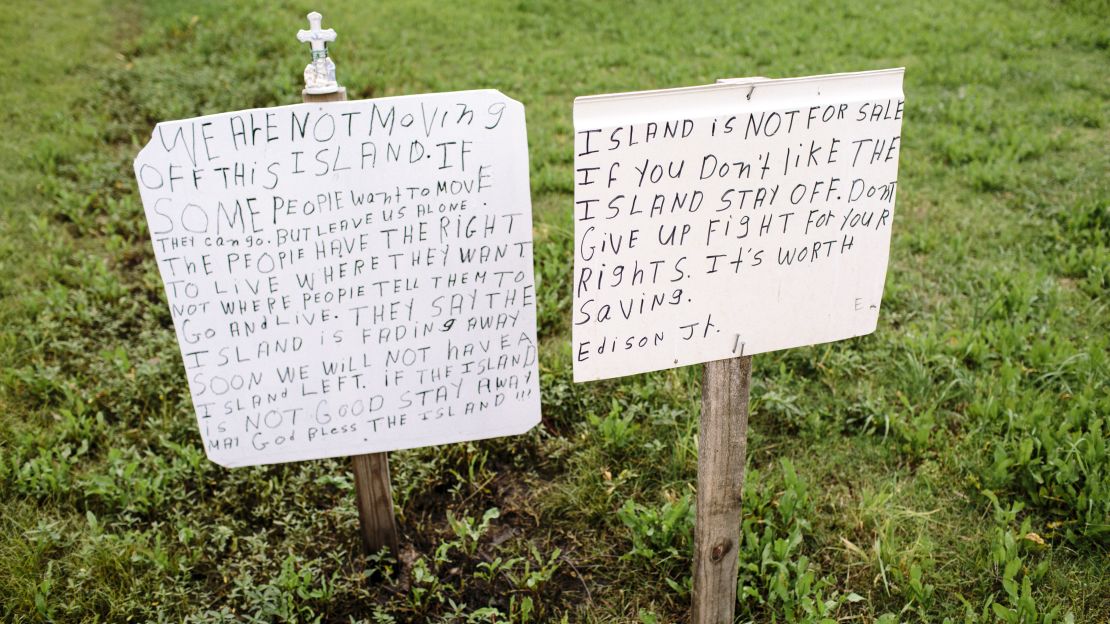Editor’s Note: John D. Sutter is a columnist for CNN Opinion who focuses on climate change and social justice. Follow him on Snapchat, Facebook and email. The opinions expressed in this commentary are his.
Story highlights
John Sutter: The marsh of Louisiana's fragile coast is disappearing at a mind-blowing rate.
To fight rising seas, he says, the world needs to reduce fossil fuel use, slowing climate change
Wenceslaus Billiot, an 89-year-old with suede-soft eyes and a bayou-French accent, asked me to follow him onto the second-story balcony of his stork-legged house here in the southern Louisiana marshland.
He held up a broom made of dried palmetto leaves and pointed way off into the distance.
See that tiny water tower? he asked.
The tower was on the horizon – so distant that it appeared to be only about as tall as my pen was wide. Aside from a few tufts of marsh between us and the tower, there was mostly water.
All of that used to be solid land, he told me.
Now: “There’s nothing but water.”
This isn’t some back-in-the-day, old-folks-exaggerating type of story. As Billiot knows all too well, the marsh of Louisiana’s fragile coast is disappearing at a mind-blowing rate.
A football field of land, on average, falls into the Gulf each hour.
That bears repeating: A football field of land, per hour, gone.
Related: 15 scary facts about sea level rise

Isle de Jean Charles, the mostly French-speaking, Native American community where Billiot lives, once was about the size of Manhattan. Now, it’s about a third of Central Park.
The coastal island has lost 98% of its land since 1955.
And what’s left is going fast.
“I don’t know how long we’re going to stay here,” Billiot told me.
“If a hurricane comes, we’re wide open.
“There’s no more land.”
‘Climate refugees’
This is an environmental tragedy – and one locals didn’t cause.
Figuring out exactly what caused a particular patch of marsh to disappear is “like doing an autopsy without the body,” said Denise Reed, chief scientist at The Water Institute of the Gulf.
But researchers do know which factors are at play.
Shortsighted government officials have strangled the Mississippi River with so many dams and levees that it doesn’t deliver the soil that’s needed to rebuild the marshes. Instead, all of that useful dirt, which normally would be deposited slowly as the river wiggles across a wide and free delta, is rushed out to the bottom of the sea.
Oil and gas canals and pipelines, meanwhile, have carved up what’s left of the marsh, making it more vulnerable to collapse.
And global warming is delivering the knockout punch.
Because as the marsh crumbles, the seas also are rising.
As we burn fossil fuels for heat and electricity we’re warming up the planet, causing ice sheets to melt and ocean water to expand as it heats up. Gradually, that causes sea levels to rise. Tides get higher. Storms and floods, which, of course, always have existed, become more threatening. The latest scientific evidence suggests seas could rise 2 meters, or 6 feet, by the end of the century. That would be catastrophic for many coastal communities in Louisiana and could drown entire island nations in the Pacific.

Scientists already are measuring the shift. In Grand Isle, Louisiana, not far from Isle de Jean Charles, where Billiot has spent most of his life, the mean sea level rose at a rate of about 1 meter per 100 years between 1947 and 2014.
Isle de Jean Charles, sadly, is one of the places wrestling with this trend first.
Earlier this year, the U.S. Department of Housing and Urban Development pledged to give the community a $48 million grant to help everyone move off the island and to a safer location.
“We’re unfortunately the perfect laboratory for experimenting” with what to do when a coastal community no longer can survive erosion and sea-level rise, said Pat Forbes, executive director of the Louisiana Office of Community Development, which applied for the grant on the community’s behalf.
Headlines rushed to declare this a village of “climate refugees.”
Raised in a hurricane
I don’t see Wenceslaus Billiot that way.
He’s more of a survivor.
In the 1920s, his mother outlasted a hurricane with him in the womb.
(As he tells it, she basically tied a small boat to a tree and rode the thing out.)
During World War II, he told me, his ship was struck by a typhoon in the middle of the Pacific. But since Billiot has spent most of his life on the water – on tugboats, oyster boats and tiny wooden pirogues, like the one he used to paddle to grade school – he didn’t get seasick. He used his sea legs to help take care of vomiting comrades.
Billiot’s home on Isle de Jean Charles has flooded more times than he can count. One of the worst followed a hurricane in 2002 or 2003, he said. Water rose over the stovetop and mud filled the oven. But he and his wife, Denicia – now 91 and the oldest person still living on this remote island – didn’t relocate, as many of their younger neighbors did. Instead, they had their hand-built house boosted up on stilts.

They couldn’t think of leaving.
Billiot grew up on this island. He fell in love on this island (he and Denicia have been married since 1947, they told me; they grew up playing together as children), built a home on this island and raised his six children here.
Several family members live nearby. His brother-in-law Albert Naquin, the local chief, lives up the road in neighboring Montegut.
“People say, ‘Oh man, it’s beautiful out here,’” the chief told me. “But it’s just a skeleton of how it was when we were kids. It’s really terrible to see.”
Billiot’s and Naquin’s ancestors were among the members of the Biloxi-Chitimacha-Choctaw tribe who settled this way-out-in-the-middle-of-nowhere place in the 1830s, well before there were roads. They did so to try to hide from racist federal policies, according to Naquin. They didn’t want their children rounded up and sent to government boarding schools – or sent down the Trail of Tears to Indian Territory.
This is a place that doesn’t give up.
It’s also a place that’s expert at hiding.
In that context, it’s hard not to see environmental collapse as another invasion.
‘We are not moving’
State officials, however, tell a sanitized story.
“They were ecstatic” when the relocation grant was approved, Forbes, the state agency head, said of the island’s residents. “They had been looking at ways to get the community moved.
“They recognize the danger they’re in and they’re very excited to be able to move.”

Locals do recognize the danger.
They’ve been flooded and rebuilt time and again.
But they’re certainly not excited about going.
“We are not moving off this island,” says a handwritten sign that’s staked in front of a teal house on the drive into town. “Some people want to move. They can go. But leave us alone. The people have the right to live where they want not where people tell them to go and live.
“They say the island is fading away,” the sign continues in shaky writing. “Soon we will not have an island left. If the island is not good stay away. May God bless the island!!!”
The message is signed with the name Edison.
I met Edison as he was unpacking groceries from his car, but it wasn’t a pleasant encounter. He told me – understandably, given the national microscope – that he’s sick of reporters asking him questions about the sign. He wouldn’t talk more unless I paid him $30.
I declined.
That’s not something journalists do.

And the sign speaks for itself, anyway.
Down the street, I met locals who either didn’t know about the relocation plan or who said they wouldn’t leave. “Oh, that’s crazy!” an older woman in a striped shirt and plaid skirt told me. “Everybody loves it here; it’s a beautiful place.”
She doesn’t plan to go.
Neither does Gillis Dardar, 65. “That ain’t for me,” he said.
“When there’s a big hurricane it brings a lot of water. That’s it,” he added. “We never have no trouble here.”
I sympathize with this stubbornness. Last summer, I visited the Marshall Islands, a low-lying country in the middle of the Pacific that may drown as oceans continue to rise. Unlike Isle de Jean Charles, however, that country’s government is digging its heels in and refusing to leave. Delegates from the country led a charge at the COP21 climate talks in Paris in December to push for the ambitious global target of holding warming to 1.5 degrees Celsius above preindustrial levels. For many Marshallese, to consider leaving is to admit defeat.
They believe the rest of the world must cut pollution and ensure their survival.
I asked Forbes, the Louisiana official, about the holdouts.
No one will be forced to leave Isle de Jean Charles, he told me. But “none of our grant will be spent on maintaining or enhancing services on the island,” he said.
There’s also no guarantee the town will remain viable.
‘Dead end’
There’s only one route in or out of Isle de Jean Charles: Island Road.
It’s a two-lane arrow across the Gulf – a sort of no-elevation bridge.
There’s one noticeable sign: “Dead end.”
When tides are high, or when winds blow in water from the south, the ocean laps over the street, rendering it impassable.
Related: Stop selling the ocean
Theresa Billiot, 58, Wenceslaus Billiot’s daughter, who lives with her parents to care for them, told me she’s been stuck on the far side of that road for days at a time. She worries she might not be able to help them in an emergency.
Wenceslaus Billiot knows it’s not safe for him to live on the island much longer.
He told me he’s mostly sure that he’s going to move to the new town.
But I could tell he’s uncertain.
Maybe moving feels like admitting defeat.
It isn’t, of course. The relocation plan is an indictment of us – not him.


We’re the ones burning fossil fuels to create global warming. We’re the ones who let the Mississippi River be strangled to the point it doesn’t function well. And we’re the ones who let energy companies scar this beautiful landscape.
We all have a hand in this tragedy.
The federal and state governments see Isle de Jean Charles as a pilot community.
I hope that’s true in the sense that this transition will be handled with grace and dignity – that the new community, wherever it’s located, will preserve as much of the local culture as is possible. Naquin told me he’s confident life will be better off of the island. Only about 25 to 30 homes remain there, he said, and many people already have moved away. The hope is the new town will reunite people.
But I also hope this pilot relocation doesn’t have to be repeated thousands of times around the globe. I worry it will. Some communities doubtlessly will be displaced by climate change and rising seas. There will be far fewer of them, however, and the changes will happen far less rapidly, if we ditch fossil fuels as fast as possible.
Perhaps the story of Isle de Jean Charles will serve as a wake-up call.
Billiot, for his part, started to understand just how bad the situation was some time ago when he went to a barbershop in a neighboring town.
On the wall was a map of Louisiana, he told me.
It was labeled 2050.
Isle de Jean Charles was gone.
The 89-year-old knows he won’t live to see that day.
But he’d hoped the island would.













